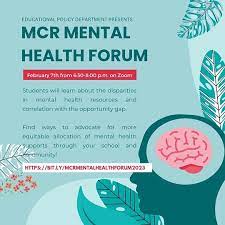MCPS’ wellness resources: a good effort but ineffective

Flyer courtesy of the Montgomery County Regional Student Government Association
This past February, the Educational Policy Department of the Montgomery County Regional Student Government Association (MCR-SGA) held a community forum to discuss mental health resources in MCPS. Many students brought up the gaps that they saw and why they thought improvements were necessary.
March 2, 2023
A, B, C: Advisory classes, Be Well 365 and counselor lessons on restorative justice, mindfulness and more. MCPS boasts a plethora of programs for its K-12 students that aim to address the gaps in social emotional learning at school, but how effective are these really?
According to the United States Office of Population Affairs, an estimated 49.5% of adolescents have had a mental health disorder at some point. It is clear that teen mental health continues to be one of the primary issues school systems must address. However, it is also clear that current MCPS support programs are not effectively reaching students, which remains a presently insurmountable barrier to resolving this crisis.
In past years, MCPS has placed a larger emphasis than ever on funding support for the mental health of students, and MCPS student advocates such as the Montgomery County Regional Student Government Association (MCR-SGA) have targeted their efforts on improving those mental health supports and initiating conversations, holding Mental Health Community Forums with both MCPS professionals and students.
The fact remains, however, that the average MCPS or WCHS student is unaware of these ongoing efforts, and this is the first aspect of the problem: many students simply either do not know about the existence of these programs, or they do not care about them. Why?
When confronted with a daunting daily to-do list of all of their assignments, it is the natural choice for students to cut out anything else that distracts them from their academic goals. The issue at hand, then, is that students view the mental health interventions in their school days as distractions, and dismiss them as such.
The aforementioned advisory lessons, BeWell 365 guideline incorporations and programs such as the Bridge to Wellness are examples of this. Advisory lessons are perceived as taking valuable time away from their classes and academic downtime, so students are more inclined to not pay attention to the content presented. Many teachers are already too overwhelmed to actively try to engage their students in social-emotional learning, and even when they do, students roll their eyes and view it as overstepping.
Furthermore, valuable resources such as the Bridge to Wellness, school psychologists and school social workers are not publicized to students in a way that would allow them to know about them even without actively intending to. It must be acknowledged that the students who need mental health support the most can be the ones who are most reluctant to recognize their internal struggles and seek out help, so it is the responsibility of MCPS to make sure that these programs are easily accessible and visible to every single student.
The second, arguably more important, aspect of the problem is that these programs do not address the root cause of the teen mental health program, which is stress. Simply put, these programs are reactionary, instead of being proactive.
If the average MCPS student were to be asked what the greatest source of their stress was, it would not be incorrect logic to assume that the vast majority of them would answer “school”, “grades” or “academic culture.” This last phrase is the most important to consider in this discussion: even without intending to, many schools, including WCHS, have an academic culture that can be toxic at times, pressuring students to take the hardest classes, get the highest grades and all the while maintain a perfect extracurricular track record.
It is then a natural progression for students to begin comparing themselves to their peers, and push themselves in ways that forces them to sacrifice the prioritization of their own mental health. If MCPS truly wants to help its students thrive emotionally and socially, not just academically, it must take a step back and consider what it can do to create more supportive and relaxed academic environments.
Recent MCPS measures, including the relaxed deadlines and the 50% rule, have had monumental impacts on students’ mental health. Although it is true that they remain controversial in whether or not they hurt students’ academic progress and stamina, the breathing room they have created has been a critically important step; it could even be said that this is the most directly impactful step MCPS has taken for its students.
It is undeniable that these programs are better than nothing, and that MCPS is doing the right thing in continuing to expand efforts to combat the crisis of teen mental health. No one will argue that these programs are completely ineffective, but what people will argue is that new directions and new implementations of these programs must be explored before it is too late.
All MCPS students, staff, parents and community members are invested in the same goal: ensuring that MCPS is a safe and healthy environment that has the resources to support its students’ needs. Thus, when it is clear that the current system can be improved, it is our responsibility to take notice of that fact and do our best to figure out what steps can be taken to help our students in the way they need it the most.


